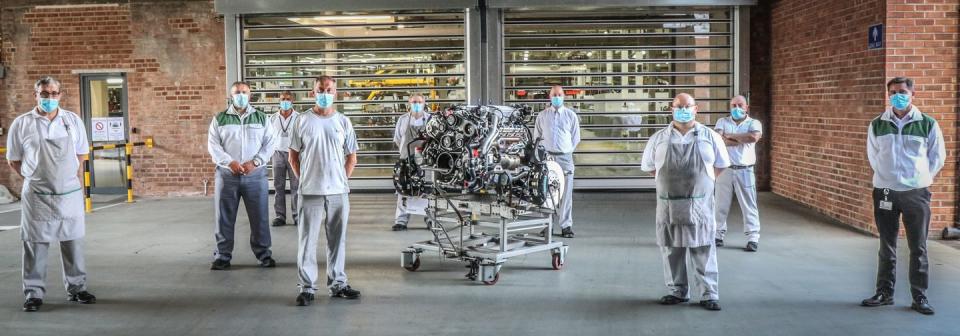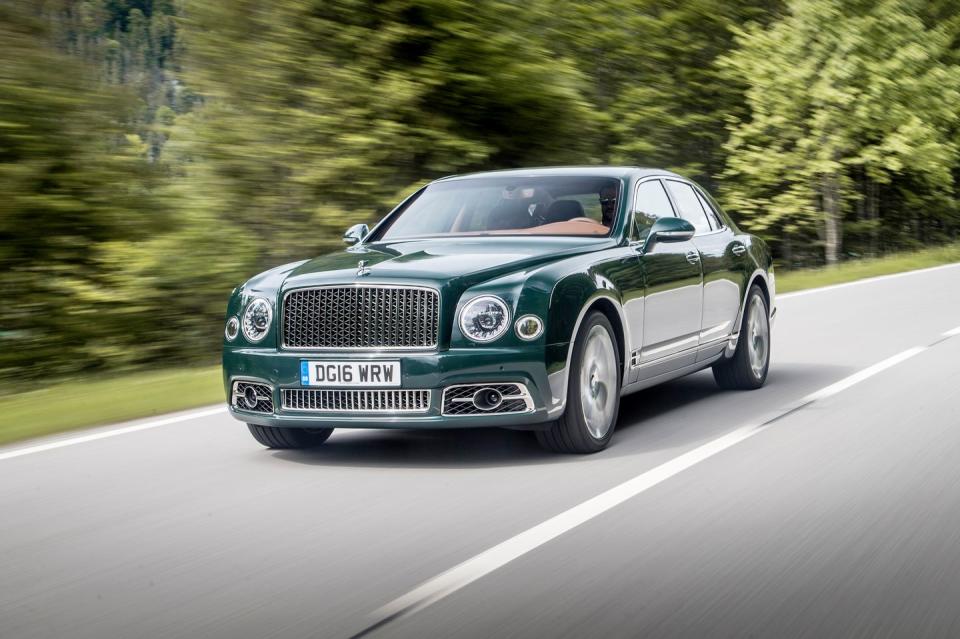Bentley 6.8-Liter Engine, Longest V-8 in Continuous Production, Is No More

Requescat in pacem: Bentley has retired the venerable L-series engine popularly known as the 6.75-liter V-8, with the final engine in its long history built for a Mulsanne on Monday, June 1.
Bentley says it's the "longest-serving V-8 engine in continuous production in history," lasting almost 62 years and with 36,000 units built.
Why's it going away? Euro 7 emissions standards are one reason. We take a fond look back at some of the great Rolls-Royce and Bentley cars that featured it.
The end was long coming: Bentley has pulled the plug on the venerable 6.8-liter V-8. After almost 62 years and 36,000 units, the powerplant that started out in 1959 is meeting its fate together with the Bentley Mulsanne sedan, its last application. Bentley wouldn't be a modern-day luxury brand if they wouldn't exploit the occasion with a special edition of the Mulsanne that features V-8–themed decor —such as a stylized oil filler cap—virtually everywhere.

The L-series engine was developed to replace a straight-six; its power rating went undisclosed at the time, although Bentley claims today that it made around 180 horsepower. It was fitted to virtually every Bentley and Rolls-Royce model down the road, and its power rating was famously described by the automaker only as "adequate."
Initially launched with 6.2 liters (or 380 cubic inches) of displacement, the aluminum engine was enlarged to 6.8 liters (412 cubic inches) in the late 1960s. In 1976, German magazine Motor Revue remarked: "Perhaps the true reason for the reluctance is not British understatement." Then they proceeded to test its output: a mere 154 horsepower, resulting in lackluster performance: zero to 62 mph in 11.6 seconds, top speed 114 mph. Fuel economy? 9.1 mpg.
When Motor Revue tested the still-carbureted successor of the Silver Shadow, the Silver Spirit, in 1981, output had risen to 196 horsepower. The verdict: "This power is certainly adequate for a Rolls-Royce, which will rarely be required to serve up even its unimpressive performance." Which was virtually identical with the Silver Shadow's.
Shortly thereafter, turbocharging made all the difference. With the intention of differentiating Bentley further from Rolls-Royce, the force-fed V-8 made its first appearance in the Bentley Mulsanne Turbo. "Adequate plus 50 percent," the company told the public back then. Claimed zero-to-60-mph times dropped to a mere 7.0 seconds, and top speed rose to 135 mph. All of a sudden, Bentley was a contender.
The potential of the low-revving, torquey V-8 was further unleashed with subsequent derivatives like the Turbo R and Turbo RT; in the two-door Continental R and T and the Azure, it reached more than 400 and eventually 500 horsepower.
Of course, those two-door cars were made in very small numbers, and before the year 2000, the L-series V-8 seemed to be heading for extinction. Under BMW's stewardship, Rolls-Royce and Bentley had developed the Silver Seraph and Arnage twins to be powered by highly modern, BMW-bred engines: a 5.4-liter V-12 in the Silver Seraph, and a turbocharged 4.4-liter V-8 in the Arnage. Those models were the backbone of the brands, and there was literally no space for the ancient L-series V-8.
But the battle over Bentley and Rolls-Royce, fought out between Volkswagen and BMW, changed everything. After a corporate battle that had traditionalist watching aghast, BMW ended up with Rolls-Royce, while VW took over Bentley. And they had no interest in relying on BMW for the heart of the Arnage.
The L-series engine, discarded by BMW, was wheeled out again, and soon Bentley reinstalled the traditional unit in the Arnage "Red Label." BMW's much smaller V-8 was allowed to continue as the "Green Label," to its utter humiliation: Almost 100 per cent of Arnage customers chose the much torquier L-series unit. The "Green Label" was killed unceremoniously. Rolls-Royce continued with its own V-12, eventually enlarged to the traditional L-series displacement in the Phantom.
Its final iteration was launched in 2010 with the Mulsanne, Bentley's top offering. Rated at 507 horsepower and 752 lb-ft of torque, it delivered the "effortless wave of torque for which Bentley is renowned"—in the company's own words, which we were able to corroborate on several memorable drives. 2015 saw yet another bump in performance: the Mulsanne Speed, rated at 530 horsepower and 811 lb-ft of torque, manages a nice and even 190 mph.

But its days were numbered, not least because the lesser Bentleys, the Continental and Flying Spur models, can be specified with range-topping W-12 engines. As early as 2012, then CEO Wolfgang Dürheimer told us that the L-series engine would retire with the current Mulsanne.
In true 2020 fashion, we may be tempted to blame China: "In our new markets, customers are asking why the range ends with an eight-cylinder unit," Bentley told us a while ago. But the real blame lies with the EU. It would be exceedingly difficult to carry the traditional V-8 forward into the world of the upcoming Euro 7 emissions standards.
The L-series engine was available in an impressive list of cars, including the Rolls-Royce Silver Cloud, Phantom V and VI, Silver Shadow, Silver Spirit, Silver Spur, Corniche and the Pininfarina-designed Camargue, as well as the Bentley S2 and S3, T-series, Mulsanne, and derivatives, Azure, Continental R/T/S, and Brooklands.
We won't forget it: Its low-revving, ultra-silent operation felt like nothing else on the road, its characteristics perhaps closer to a diesel than a gasoline engine but without any of the rumble. We are glad VW kept it around for so long, and we are sad to see it go.
You Might Also Like

 Yahoo News
Yahoo News 